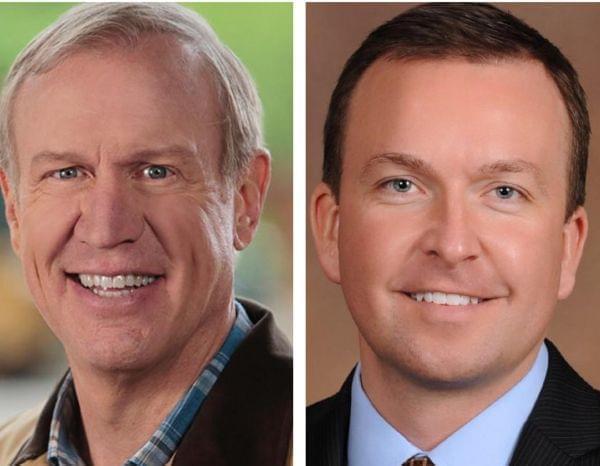Education Desk: School Funding Inequity Needs $3.5 Billion Cure

Gov. Bruce Rauner and Illinois Senator Andy Manar NPR Illinois
Last summer, Governor Bruce Rauner tasked 20 lawmakers and a handful of educators with the job of changing the way Illinois funds public schools. That bipartisan commission produced a “framework” Wednesday, but no actual legislation. That is despite the group’s continual focus on a plan favored by Rauner.
Over the course of 18 meetings, totaling more than 75 hours, the commissioners explored and tweaked every factor of the so-called Evidence-Based Model, proposed by the Illinois School Management Alliance. It’s a complex system using 27 metrics to establish a precise “adequacy target” for each school district.
State aid would then be essentially triaged, with 99 percent of any new dollars handed out first to struggling districts unable to raise enough property taxes to meet a minimum standard.
But a few days ago, when the commission finally got to test a draft version of that model using data from actual districts, the results were discouraging. For example, the poor, rural district used in the test run would have to endure an 18-year wait to achieve adequate funding.
State Senator Andy Manar (D-Bunker Hill,) represents several such districts.
“If you go back to the meeting on Monday, we commissioners got a look at some of the outcomes in terms of real numbers, and I walked away from that meeting with many, many concerns about what was lacking in that proposal.”
The current system relies heavily on property taxes, which means children in areas with thriving businesses and high-dollar housing stock enjoy schools with an array of academic resources and amenities. But children who live in low-income areas, or rural districts with one grain elevator and a Dairy Queen, may be sharing decades-old textbooks and a few outdated computers.
The commission’s goal was to try to make Illinois’ school funding structure more equitable, and the report approved today provides a few guideposts toward that goal. But it also warned that it won’t be easy without a massive infusion of more state funds on top of the $11 billion already used for k-12 education.
“Without clearly identified new resources for the framework, the $11 billion in spending will continue to be inadequate and inequitable,” according to the report.
How much? The commission agreed that $3.5 billion -- over a period of years -- would be a good start.
The commission included legislators from both parties and both chambers, and was led by Beth Purvis, secretary of education.
Links
- Rauner Pledges Support For Education As He Tours A Middle School In Champaign
- Education Desk: McConnaughay Sees Signals Of Compromise
- Is Illinois’ Education System On Track?; How Classrooms Handle Winter Weather; Dial-A-Carol
- State Board Of Ed Wraps Up Listening Tour On New Education Law
- Illinois Politics; K-12 Education Report; World AIDS Day; Author Discusses ‘Make Someone Happy’
- IL Higher Ed Board Hands $17 Million To Struggling Schools
- Gov. Rauner Signs School, Daycare Lead-Testing Law
